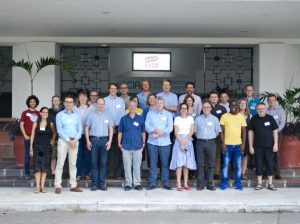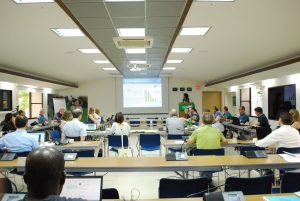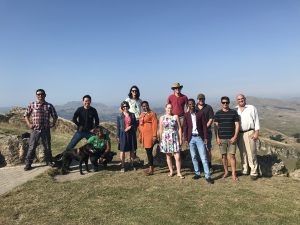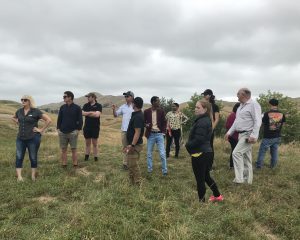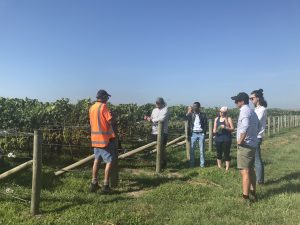The GRA’s Integrative Research Group (IRG) met in Cali, Colombia, on the 4th and 5th February 2019. This was the group’s third annual meeting, which included 36 participants from 14 GRA member countries. Experts from the International Centre for Tropical Agriculture (CIAT), Coordination of International Research Cooperation on Soil Carbon Sequestration in Agriculture (CIRCASA), Climate Change, Agriculture and Food Security (CCAFS), 4per1000, French Agricultural Research Centre for International Development (CIRAD), International Soil Reference Information Centre (ISRIC), and the EU also attended.
One of the major outcomes of the meeting was a network organisation and restructuring with existing work prioritized now across three networks; The Nationally Determined Contribution (NDC) Support Network, The Soil Carbon Sequestration Network and The Farm to Regional Integration Modelling Network. The group also agreed to the development of a series of webinars to increase science communication amongst scientists and related parties.
The meeting was attended by Australia, Brazil, Canada, Denmark, France, Ghana, the Netherlands, New Zealand, Norway, Spain, United Kingdom, United States of America and Uruguay. The purpose of the IRG is to foster collaboration in the science community across Alliance research groups and between Alliance member countries, international partnerships, research organisations and research institutions to ultimately develop international knowledge and capabilities for estimation, monitoring, and projecting greenhouse gas emissions within and across agricultural systems.
The joint Global Research Alliance – World Farmers’ Organisation annual study tour took place in New Zealand from the 26th January to the 1st February, 2019.
Farmers from Ethiopia, Kenya, Uganda, and South Sudan, representing the Eastern Africa Farmers Federation, alongside farmers from Indonesia, and the President of the World Farmers Organisation, travelled to Palmerston North and the Hawke’s Bay Region in New Zealand. On the tour participants learnt more about and discussed agricultural greenhouse gas emissions, environmental farming management, and sustainable agriculture.
The group met with representatives from the New Zealand Agricultural Greenhouse Gas Research Centre (NZAGRC), Massey University, the Hawke’s Bay Regional Council, Ravensdown Fertiliser, and Plant and Food Research, as well as farmers and producers in the Hawke’s Bay Region. The New Zealand farmers hosting the group were pleased to showcase the diversity of production and innovation across the region, including sheep and beef farms, apple and blueberry orchards, dairy goats and high value cropping. Participants in particular noted the close connection between scientists, farmers, and policy makers and the commitment from farmers to care for their environment. The tour facilitated farmer-to-farmer discussion on sustainable management practices and innovative new technologies aimed at lessening the environmental impact of agricultural production. Participants were able to share their unique experiences regarding the challenges and opportunities farmers are currently facing across the globe.
This was the fifth annual study tour to be held, and third to take place in New Zealand. Previous tours have also been held in Argentina and Italy. The purpose of the Global Research Alliance – World Farmers’ Organisation annual study tour is to increase understanding and engagement on agricultural greenhouse gas research and changing environmental management practices in order to support sustainable farming.
To read more about the tour, click here to visit the WFO website or click here to read an article by Federated Farmers.
An opportunity for a Post-Doctoral Research Assistant has arisen at the University of Reading, United Kingdom. The School of Agriculture Policy and Development (SAPD) is seeking a Post-Doctoral Researcher to contribute to on-going collaborative research and knowledge exchange activities of the Animal, Dairy and Food Chain Sciences Research Group and the Centre for Dairy Research (CEDAR).
The successful applicant will contribute to the research and knowledge exchange activities of CEDAR. Abilities to contribute to ongoing research in the areas of reducing environmental impact of animal production are important, including current research on multi-species forage production and utilization and measurement of digestive efficiency and methane emission, as well as the ability to further develop international research collaborations.
For a job description and to apply, please click here or visit https://www.jobs.ac.uk/job/BPR121/postdoctoral-research-assistant-animal-science
The application deadline is February 22 2019 (UK time) so if you’re interest be sure to apply soon.
The Global Research Alliance on Agricultural Greenhouse Gases (GRA) is very pleased to announce that three new member countries have joined the Alliance – Uganda, eSwatini and Ethiopia
In December 2018, Uganda and the Kingdom of eSwatini became members of the Alliance.
In Uganda, the agricultural sector is the most vulnerable sector to climate change. The sector contributes over 50 per cent of the country’s greenhouse gas emissions, making it a high priority sector for both climate change mitigation and adaptation efforts. The Ugandan Ministry of Agriculture, Animal Industry and Fisheries recognises that the GRA’s objectives align with those of Uganda in relation to food security, poverty reduction, and sustainable development. Working with the GRA will contribute to knowledge sharing, synergies between adaptation and mitigation, technical and scientific exchanges, and the promotion of more efficient agricultural systems.
eSwatini is committed to a national climate change agenda, including sustainable development goals, and identifies agriculture and food security as key areas of concern. eSwatini is aligned with the Global Research Alliance Charter and fully endorses it. Through collaborative efforts eSwatini and the GRA will work towards enhanced climate change mitigation and adaptation.
The GRA is also very pleased to welcome Ethiopia as our newest member country. In Ethiopia the agriculture and livestock sector is of vital importance in addressing climate change and is central to Ethiopia’s vision and objectives for a climate resilient green economy. The Ministry of Agriculture of Ethiopia is the central governmental actor in assisting Ethiopia’s transition to a climate resilient green economy and in the implementation of Ethiopia’s Livestock Master Plan. Previously, representatives from the Ethiopian Institute of Agricultural Research (EIAR) and Addis Ababa University attended the 2012 regional capability building workshop in Kenya. In 2014, participants from Ethiopia also took part in the intensive two weeks course “Introduction to Greenhouse Gas Emissions Measurement”, organised by the Livestock Research Group of the GRA. The Alliance is looking forward to working with Ethiopia to develop and improve sustainable farming practices.
The 56 member countries now participating in the activities of the Global Research Alliance are: Argentina, Australia, Belgium, Bolivia, Brazil, Canada, Chile, China, Colombia, Costa Rica, Democratic Republic of Congo, Denmark, Dominican Republic, Ecuador, Egypt, eSwatini, Ethiopia, Finland, France, Germany, Ghana, Honduras, Indonesia, Ireland, Italy, Japan, Lithuania, Malaysia, Malawi, Mexico, Mongolia, Namibia, Netherlands, New Zealand, Nicaragua, Norway, Panama, Paraguay, Peru, Philippines, Poland, Senegal, South Africa, South Korea, Spain, Sri Lanka, Sweden, Switzerland, Thailand, Tunisia, Uganda, United Kingdom, United States of America, Uruguay, Vietnam, Zimbabwe.
The Global Research Alliance is pleased to announce Malawi as our newest member country. Malawi has become the 55th member of the GRA, and the eleventh African country to have joined the Alliance.
In 2018, Malawi attended the Low Emissions Livestock: Supporting Policy Making and Implementation through Science in East Africa workshop, which was organised by the GRA together with the World Bank, the CGIAR Research Program on Climate Change, Agriculture and Food Security (CCAFS), and the Food and Agriculture Organization of the United Nations (FAO). The workshop focused on livestock production and the reduction of greenhouse gas emissions.
Malawi is looking forward to working with other member countries to develop more efficient and sustainable agricultural systems to meet growing global demand for food.
The Livestock Research Group’s Feed and Nutrition Network (FNN) seeks a qualified and self-motivated postdoctoral fellow from the Latin American region to work on a GRA flagship project related to reducing methane emissions from cattle using dietary approaches in a range of production conditions and environments. The work on the project is integrated with activities of the GLOBAL NETWORK and CEDERS projects and is an activity of the FNN. The project is coordinated by the FNN leader, based at Pennsylvania State University in the USA, and the postdoctoral position will be based at the Department of Animal Science, Agrosavia-Research Agricultural Corporation in Bogota, Colombia.
For more, including the application process, please download the PDF.
The latest issue of the Livestock Research Group (LRG) newsletter is available.
In this edition, you can read about:
- The farewell from Martin Scholten and introduction of the new LRG co-chair – Dr Sinéad Waters
- The upcoming 7th International Greenhouse Gas and Animal Agriculture (GGAA) conference and the 10th meeting of the Livestock Research Group
- New tools for measuring, reporting and verifying livestock greenhouse gas emissions and mitigation
- LRG support to the Intergovernmental Panel on Climate Change (IPCC)
- LRG involvement in a regional engagement workshop on ‘Low Emissions Livestock: Supporting Policy Making and Implementation through Science in East Africa’
- Highlights from the GRA Council Meeting and updates from the LRG’s networks
A position in Greenhouse Gas Emissions and Mitigation is available at the Department of Agroecology, Section of Soil Fertility in Denmark.
They are seeking an internationally competitive, innovative and successful research leader, who wants to work with highly engaged and motivated staff in a positive and dynamic international working environment.
Please note all applications must be made online and received no later than: 05.01.2019
For more information about the position and how to apply – click here.
The second round of successful candidates of the GRA and CGIAR Research Programme on Climate Change (CCAFS) joint CLIFF-GRADS initiative for 2019 have been announced.
CLIFF-GRADS is an international doctorate scholarship programme designed to support budding agricultural scientists.
Some 212 applicants from more than 50 developing countries applied to this latest round of the programme, as compared to 65 applicants from 23 countries in the first round earlier this year.
As such, 27 scholarships have been awarded to students from more than 18 countries in this second round, with winners announced at the UN climate talks in Poland. Students will undertake research in areas as diverse as rumen microbiology, rice production, soil science, and rangeland management, among others.
We are pleased to announce 2019 CLIFF-GRADS fellows and research projects below. Please click on the name of the student below to read more about them.
CLIFF-GRADS Call: Greenhouse gas emission and emission reduction from agricultural production
| Name | Nationality | University | Research Project | Host Institution | Host Country |
| Abmiael Ortiz-Chura | Peru | University of Buenos Aires | Effect of modulating interspecies electron transfer exchanges on methane production and rumen microbiota composition | INRA – National Institute for Agricultural Research, ARA Centre | France |
| Adnan Zahid | Pakistan | University of the Punjab | Using a Tier II Model (CQESTR) to Predict SOC Storage and CO2 Emissions | USDA -ARS, Soil and Water Conservation Research Unit | USA |
| Bertin Takoutsing | Cameroon | Wageningen University | Accounting for errors in SOC estimates introduced by proximal sensing methods | ISRIC – World Soil Information | Netherlands |
| Bo-Wen Zhang | China | Institute of Mountain Hazards and Environment, CAS | Modeling pH effects on direct N2O from agricultural soils through complex stable isotope labelling | Thünen Institute, Federal Research Institute for Rural Areas, Forestry and Fisheries | Germany |
| Camila Almeida dos Santos | Brazil | Federal Rural University of Rio de Janeiro | Targeting N2O emission hot-spots in intensive dairy pastures for mitigation action | The University of Melbourne | Australia |
| Deysi Ruiz Llontop | Peru | National Agrarian University La Molina | Quantification of carbon footprints in livestock production systems under contrasting management of Argentina | National Institute of Agricultural Technology (INTA) | Argentina |
| Hilaire Sanni Worogo | Benin | University of Parakou | Effects of rangeland management on soil carbon sequestration | USDA -ARS, Fort Keogh Livestock & Range Research Laboratory | USA |
| Kofi Boateng | Ghana | Kwame Nkrumah University of Science and Technology | Nitrogen fertilizer rate, crop residue amount and soil water content influence on N2O emissions | USDA -ARS, Soil and Water Conservation Research Unit | USA |
| Lai Lai | Myanmar | University of Putra Malaysia | Compiling a structured Rice Policy Information Portal and demonstrating its potential use in mitigation projects | International Rice Research Institute (IRRI) | Philippines |
| Lamfu Fabrice Yengong | Cameroon | University of Buea | Manure management interventions to mitigate GHG | International Livestock Research Institute, Mazingira Centre | Kenya |
| Lucélia de Cássia Rodrigues de Brito | Brazil | Federal University of Piauí | Cover crop and animal manure impacts on soil N2O emissions | USDA -ARS, Beltsville Agricultural Research Center, Sustainable Agricultural Systems Laboratory | USA |
| María Carolina Scorcione Turcato | Argentina | University of Buenos Aires | Directed evolution of rumen microbial cultures towards the identification and stimulation of electron sinks alternative to methanogenesis | National Agricultural Research Institute (INIA) | Chile |
| Mariana Eloisa Garcia Ascolani | Paraguay | University of Florida | RumenPredict: Predicting appropriate GHG mitigation strategies based on modelling variables that contribute to ruminant environmental impact | Queens University | UK |
| Mónica Gabriela Perez | Argentina | University of Buenos Aires | Understanding the controls of N2O in grazed upland and lowland systems | Bangor University | UK |
| Noriel Angeles | Philippines | University of the Philippines Los Baños | Toward low methane-emitting rice varieties | International Rice Research Institute (IRRI) | Philippines |
| Ntwanano Moirah Malepfane | South Africa | University of KwaZulu-Natal | Comparing deep soil carbon stocks under kiwifruit and pasture land use | Plant & Food Research | New Zealand |
| Paul Soremi | Nigeria | Federal University of Agriculture, Abeokuta | Turning to rice cultivars for solving the CH4 puzzle in irrigated rice systems | International Center for Tropical Agriculture (CIAT), FLAR | Colombia |
| Pierre Eke | Cameroon | University of Yaounde | Soil organic matter sensitivity to land management impact on grasslands and croplands | Thünen Institute, Federal Research Institute for Rural Areas, Forestry and Fisheries | Germany |
| Rangarirayi Lucia Mhindu | Zimbabwe | Chinhoyi University of Technology | GHG emissions from adequately managed rangelands in Kenya | International Livestock Research Institute (ILRI), Mazingira Centre | Kenya |
| Ricardo González Quintero | Colombia | Universidad de Antioquia. Medellín | Measuring ammonia emissions and collecting farm data from Costa Rican dairies | Tropical Agricultural Research and Higher Education Center (CATIE) | Costa Rica |
| Samuel Anuga | Ghana | University of Ghana | Just how smart are the climate smart options promoted in the Climate Smart Villages of Nicaragua? | International Center for Tropical Agriculture (CIAT), FLAR | Colombia |
| Sebastian Bedoya Mazo | Colombia | University of Antioquia | Quantifying Hydrogen fluxes and their impact on methane production equations | National Institute for Agricultural Research (INRA), ARA Centre | France |
| Sikiru Yusuf Alasinrin | Nigeria | Federal University of Agriculture, Abeokuta | Net GHG and soil carbon sequestration in response to tillage systems and cropping sequences | USDA -ARS, Northern Plains Agricultural Research Laboratory | USA |
| Thi Thanh Ha Do | Vietnam | Southern Cross University | Assessing (agro)forestry landscape restoration options in livestock-degraded regions of montane Kenya and Tanzania | Center for International Forestry Research (CIFOR) | Kenya |
| Titis Apdini | Indonesia | Wageningen University | Economic implications of GHG mitigation from dairy and beef systems | Bangor University | UK |
| Victor Ilich Alvarado Bolovich | Peru | National Agrarian University La Molina | GHG mitigation strategies on cow/calf production systems | National Institute of Agricultural Technology (INTA) | Argentina |
| Yuri Gelsleichter | Brazil | Federal Rural University of Rio de Janeiro | Assessing the impact of land use change scenarios on soil organic carbon stocks | ISRIC – World Soil Information | Netherlands |
CLIFF-GRADS Call: Greenhouse gas emission and emission reduction from reduced food loss and waste
| Name | Nationality | University | Research Project | Host Institution | Host Country |
| Daniele Eckert Matzembacher | Brazil | Universidade Federal do Rio Grande do Sul | Measure FLW reduction and associated emission reductions of Brazilian entrepreneurship initiatives in fruits and vegetables that do not meet retail aesthetic standards | Swedish University of Agricultural Sciences | Sweden and Brazil |
| Laura Holguin | Colombian | Technical University of Dresden | Characterize digestate option with different combinations of available waste, including yield impacts, methane, and soil-based emissions | International Centre of Tropical Agriculture (CIAT) | Colombia |
| Li Xue | China | Chinese Academy of Sciences | Quantifying GHG emissions of agrifood chain and associated food loss and food waste in China: an input-output analysis. | University of Southern Denmark | Denmark and China |
| Norah Titiya Machinjiri | Malawi | Haramaya University | Effects of organic matter soil amendments on population dynamics of Aspergillus flavus and its natural antagonists; and on groundnut aflatoxin contamination in Malawi. | International Crops Research Institute for the Semi-Arid Tropics (ICRISAT) | Malawi |
| Tabitha Nindi | Malawi | Purdue University | Understanding smallholder farmers’ storage habits in Malawi. | Malawi University of Science and Technology | Malawi |
| Xia Liang | China | The University of Melbourne | Evidence base for the mitigation of N2O emission from reduced food loss and waste in China and Myanmar | Hokkaido University | China and Myanmar |
These awards included funding from the New Zealand government and via support to CCAFS from CGIAR Trust Fund Donors and through bilateral funding agreements. The United States government, through the USAID Sustainable Landscapes program, also funds and supports food loss and waste research.For information regarding the last round of CLIFF-GRAD recipients -click here. Alternatively, click here for more information about the CLIFF-GRADS programme.
The final summary report is now available from the ‘International Conference on Agricultural Greenhouse Gas Emissions and Food Security – Connecting Research Policy & Practice’ focused on agricultural GHG emission reduction in light of climate change, sustainable agriculture, and food security.
The conference was held on the 10-13 September 2018 in Berlin, Germany, alongside the GRA Council meeting, and brought together approximately 300 scientists and stakeholders from government, public administration, industry and farmer organisations. Thematic discussions brought together participants to discuss key challenges facing agricultural production and the reduction of GHG emissions from both a scientific and policy perspective identifying a key statements and recommendations for each topic.
A few key take away messages:
- A greater focus on how to act upon scientific findings and implement scientific recommendations is needed
- Move to a science of implementation, not just the science of options or measurement
- More boldness in policy design: large-scale initiatives and learning
- Co-designing solutions with farmers, investors, input suppliers, advisory services to mainstream mitigation is essential
- For MRV regional data platforms, novel methods and information systems are promising solutions
- Higher priority to reduce loss and waste: food and other resources – circularity
- Ensuring effective policy coordination and coherence
- political will – we need it all: top-down and bottom-up, good governance
- Koronivia Joint Work on Agriculture: science, practice and policy – all have a role to play
The conference was organised by the Global Research Alliance (GRA) and the Joint Programming Initiative on Agriculture, Food Security and Climate Change (FACCE-JPI) of the European Commission, in partnership with CGIAR-CCAFS and funded by the German Federal Ministry of Food and Agriculture and supported by its Federal Research Institute for Rural Areas, Forestry and Fisheries (Thünen Institute).
Each organisation presented to conference participants on their key research achievements and outcomes and provided a wrap up of the key outcomes from the conference. The organisations were represented by:
- Hayden Montgomery (GRA Special Representative)
- Hartmut Stalb (Chair of FACCE – JPI)
- Bruce Campbell (CCAFS & CGIAR Representative); and
- Lini Wollenberg (Flagship Leader of Low Emissions Development at CCAFS (USA))
Click here to view the final summary report.
Alternatively, to learn more about the conference click here for the final summary slides.
Accounting for greenhouse gas emissions and emissions reductions correctly is essential to achieve climate change mitigation.
The MRV Platform for Agriculture provides information to guide measurement, reporting and verification (MRV) systems for agricultural emissions and mitigation, such as for Nationally Appropriate Mitigation Actions (NAMAs) and Nationally Determined Contributions (NDCs).
The platform houses a wide range of tools, approaches, and case studies about how to design and implement MRV of greenhouse gas (GHG) emissions and mitigation actions in the livestock sector. The platform will expand to include other agriculture sectors over the next year.
“The MRV Platform is meant to be a one-stop entry point on MRV topics for compilers of national GHG inventories, developers of national and subnational mitigation actions, preparers of climate finance proposals, and teams in agriculture and environment ministries responsible for NDC implementation and revision. Agricultural development agencies could also use the MRV Platform to track the GHG impacts of their projects,” explained Sinead Leahy, International Capability and Training Coordinator with the New Zealand Agricultural Greenhouse Gas Research Centre, which contributed funding and helped develop the platform on behalf of the Global Research Alliance.
Describing approaches that work, from ‘good enough’ to ‘gold standard’
A 2017 review of current MRV practices in the livestock sector found that there was a lack of examples of approaches and methods used in MRV at different levels (national, sub-national, and project) that were applicable for developing country systems. The MRV Platform aims to fill this gap.
“Over 100 countries indicated their intention to reduce emissions from the agriculture sector in their NDCs, and all of them need credible MRV systems,” Meryl Richards, Science Officer for CCAFS and faculty at the University of Vermont, said. “We want to ensure that inventory compilers and project developers have access to the information they need and examples of how others have solved the same problems they may be facing.”
The MRV Platform summarizes evidence-based approaches to practicing MRV. Andreas Wilkes, consultant with UNIQUE land use and forestry GmbH, authored over 30 case studies now housed on the platform.
“The case studies examine how common challenges have been addressed,” he said. “For example, animal weight data are necessary for estimating emissions from cattle. But what do you do when you don’t have those data at a national level?”
This MRV Platform for Agriculture is an initiative of the GRA and the CGIAR Research Program on Climate Change, Agriculture and Food Security (CCAFS), implemented in partnership with UNIQUE forestry and land use GmbH and with web design by Clutch Creative. Funding was provided by the New Zealand Government as an activity of the GRA.
The United States is pleased to continue providing fellowship opportunities through the “Global Research Alliance” special program within the U.S. Department of Agriculture’s (USDA) Borlaug International Agricultural Science and Technology Fellowship Program. The 2019 application window is open now through December 31, 2018.
Click here for the 2019 GRA Special Program announcement:
- Eligible Countries include: Colombia, Costa Rica, Egypt, Ghana, Honduras, Indonesia, Malaysia, Mexico, Nicaragua, Panama, Peru, Philippines, Thailand, Vietnam
Additional information on the Borlaug Fellowship Program can be found here.

